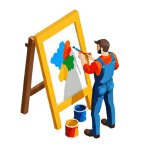Welcome Painters! Master the Art of Painting Textures
Introduction
Welcome to our self-guided online lesson on how to paint textures. As a painter, understanding and mastering textures is essential for bringing depth, realism, and interest to your artwork. Whether you're aiming to capture the roughness of a brick wall, the softness of a feather, or the sheen of a glass surface, learning to paint various textures will elevate your skills and take your paintings to the next level.
In this lesson, we will explore different techniques, tools, and approaches that can help you effectively replicate a wide range of textures in your paintings. From understanding the importance of light and shadow in creating texture to experimenting with different brush strokes and mediums, this lesson is designed to provide you with the knowledge and inspiration to enhance your painting repertoire.
So, grab your brushes and let's dive into the wonderful world of painting textures!
Texture in painting refers to the surface quality of a painting, which can be smooth, rough, shiny, or matte. Understanding and creating different textures can add depth and visual interest to your artwork. Here are some key points to keep in mind when aiming to achieve various textures in your paintings:
1. Visual and Actual Texture: There are two types of textures in painting - visual texture and actual texture. Visual texture is the illusion of texture created through the artist's use of color, line, and other elements. Actual texture is the physical texture you can feel on the surface of the painting.
2. Experiment with Different Techniques: To create a variety of textures, experiment with different painting techniques such as dry brushing, palette knife painting, impasto (thick layers of paint), or glazing (thin transparent layers). Each technique can produce unique textures.
3. Use Different Tools: Utilize a variety of tools and materials to create textures in your painting. Brushes, sponges, palette knives, and even unconventional tools like credit cards or toothbrushes can be used to achieve different effects.
4. Layering and Mixing Mediums: Layering paint and mixing mediums can also help create interesting textures. Try layering thin washes of paint over a textured surface or mixing sand, sawdust, or other materials with your paint for added texture.
5. Study Texture in Nature: Observing textures in nature can be a great source of inspiration. Study how light interacts with different surfaces and textures in the world around you to inform your painting techniques.
By understanding texture in painting and experimenting with different techniques and materials, you can elevate the visual appeal of your artwork and create rich, dynamic compositions.
When it comes to painting textures, there are several techniques you can use to achieve the desired effect. Here are some key methods:
1. Dry Brushing: This technique involves using a dry brush with very little paint on it to create a textured look. Dip the brush lightly into the paint and then remove most of it by wiping it on a paper towel. Gently brush the surface to create a subtle texture.
2. Sponging: Sponging is a great way to add depth and dimension to your painting. Simply dip a natural sponge or sea sponge into the paint and then lightly dab it onto the surface. Experiment with different pressures and angles to achieve various textures.
3. Palette Knife: Using a palette knife can create interesting textures by applying thick layers of paint and then sculpting or scraping it to create different effects. This technique works well for creating rough or impasto textures.
4. Stippling: Stippling involves using a brush to create a textured effect by dabbing or stippling the paint onto the surface. Vary the pressure and size of the brush to create different textures, from fine to coarse.
5. Layering: Layering different colors and textures can also create interesting effects. Start with a base layer and then add subsequent layers using different techniques to build up depth and complexity in your painting.
Experiment with these techniques and combine them to create unique textures in your paintings. Remember, practice is key to mastering these techniques, so don't be afraid to try new things and see what works best for your artistic vision.
Exploring Different Painting Tools
When aiming to create various textures in your paintings, the choice of painting tools plays a significant role in achieving the desired effects. Here are some common painting tools that you can experiment with:
1. Brushes: Different types of brushes can be used to create a range of textures. Stiff bristle brushes are great for creating rough textures, while soft brushes can help achieve smooth and blended textures. Experiment with various brush sizes and shapes to see how they affect the texture of your painting.
2. Palette Knives: Palette knives are versatile tools that can be used to create unique textures in your paintings. They are especially useful for applying thick layers of paint and creating impasto effects. Use the edge of the palette knife to scrape and carve textures into the paint.
3. Sponges: Sponges can be used to create soft and subtle textures in your paintings. Simply dab the sponge in paint and gently press it onto the canvas to create interesting patterns and effects. You can also experiment with different types of sponges for varying textures.
4. Rollers: Paint rollers are excellent tools for creating uniform textures and patterns in your paintings. They can be used to apply paint evenly across large areas, or you can roll them over wet paint to create interesting textures and designs.
By exploring and experimenting with different painting tools, you can discover new ways to add depth and interest to your artwork through a variety of textures.
Experimenting with mixed media is a fantastic way to add depth and interest to your textured paintings. By combining different materials and techniques, you can create unique textures that will make your artwork stand out.
One popular approach is to mix acrylic paint with various mediums such as sand, modeling paste, or even coffee grounds to create gritty textures. Experiment with different ratios to achieve the desired effect – you can even add a touch of color to these mixtures for added visual interest.
Another creative option is to incorporate collage elements into your painting. Try tearing up pieces of paper, fabric, or even dried leaves and embedding them into your artwork. This technique adds both visual and tactile texture to your piece.
Don't be afraid to think outside the box when it comes to mixed media – consider incorporating unconventional materials like string, beads, or even metal shavings into your painting. These unexpected elements can add a sense of whimsy and dimension to your textured artwork.
To truly elevate your painting to a new level of artistic expression, incorporating textures can add depth and visual interest to your artwork. Here are some techniques to help you apply texture effectively:
1. Use Various Tools: Experiment with different tools to create unique textures in your painting. Consider using palette knives, sponges, brushes with stiff bristles, or even unconventional items like credit cards or combing tools to add interesting textures to your artwork.
2. Layering: Build up layers of paint to create depth and dimension. Apply thick layers of paint and use various techniques such as dry brushing or stippling to create tactile textures that stand out in your painting.
3. Mixing Mediums: Mix your paint with different mediums such as modeling paste, sand, or gel to create customized textures. Experiment with different ratios to achieve the desired level of texture in your artwork.
4. Play with Light and Shadow: Use textures to enhance the play of light and shadow in your painting. By incorporating textures strategically, you can create visual interest and add a dynamic quality to your artwork.
5. Practice and Experiment: The key to mastering texture in painting is practice and experimentation. Take the time to play around with different techniques and materials to discover what works best for your artistic style.
Mastering Textures for Artistic Expression
In this lesson, we delved into the intricate world of painting textures, a crucial aspect of achieving artistic expression. By understanding the different techniques and approaches to creating textures in your artwork, you are able to infuse depth and emotion into your paintings.
Continuing Your Artistic Journey
Remember, the pursuit of mastering textures is an ongoing journey. If you feel the need to revisit any part of this lesson, take the time to do so. Additionally, explore the other lessons in this course to expand your knowledge and skills further.
Lesson Audio

